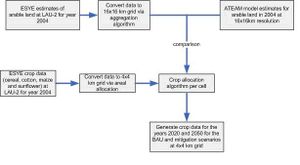Crop allocation

- The text on this page is taken from an equivalent page of the IEHIAS-project.
A major task in developing the scenario for this assessment was to re-allocate crops in the Greek case study for the future scenarios, in 2020 and 2050. This is accomplished by a crop allocation algorithm, which distributes the areas of each crop on a 4x4km grid, applying the available area per grid as a constraint. The crop allocation algorithm employs two inputs: the ATEAM model estimates of arable land at 16x16km for the baseline year 2004, and the arable land data (ESYE) at a 4x4 km grid.
Firstly, for the baseline year 2004, arable land data (ESYE) are aggregated from LAU-2 to a 16x16km grid and compared to the estimated arable land (ATEAM) for the entire region of study. Variations between the two are used to normalise all scenario maps (ATEAM ) for the years 2020 and 2050.
Secondly, all crop data available at LAU-2 level for the baseline scenario are re-allocated to the 4x4 km grid and fed into the crop algorithm.